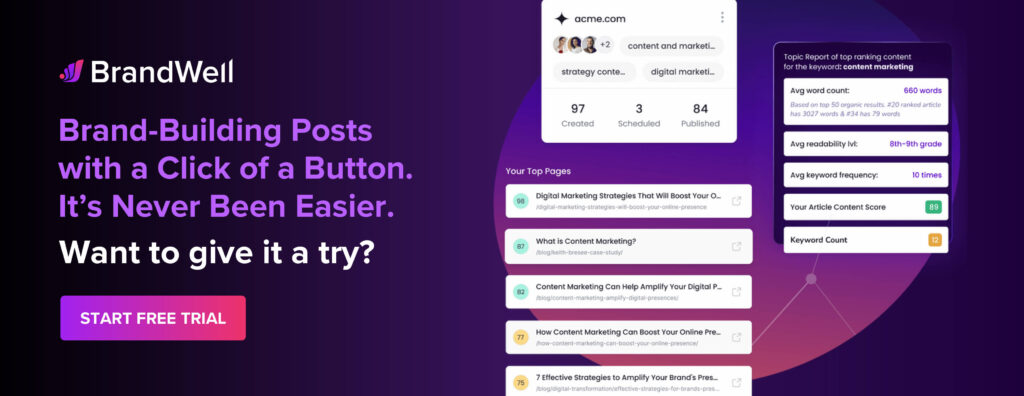Discover top guides, trends, tips and expertise from AIO Writers
Top Ranking Factors: Boost Your Site’s Google Position
Julia McCoy
Thursday, 21st Mar 2024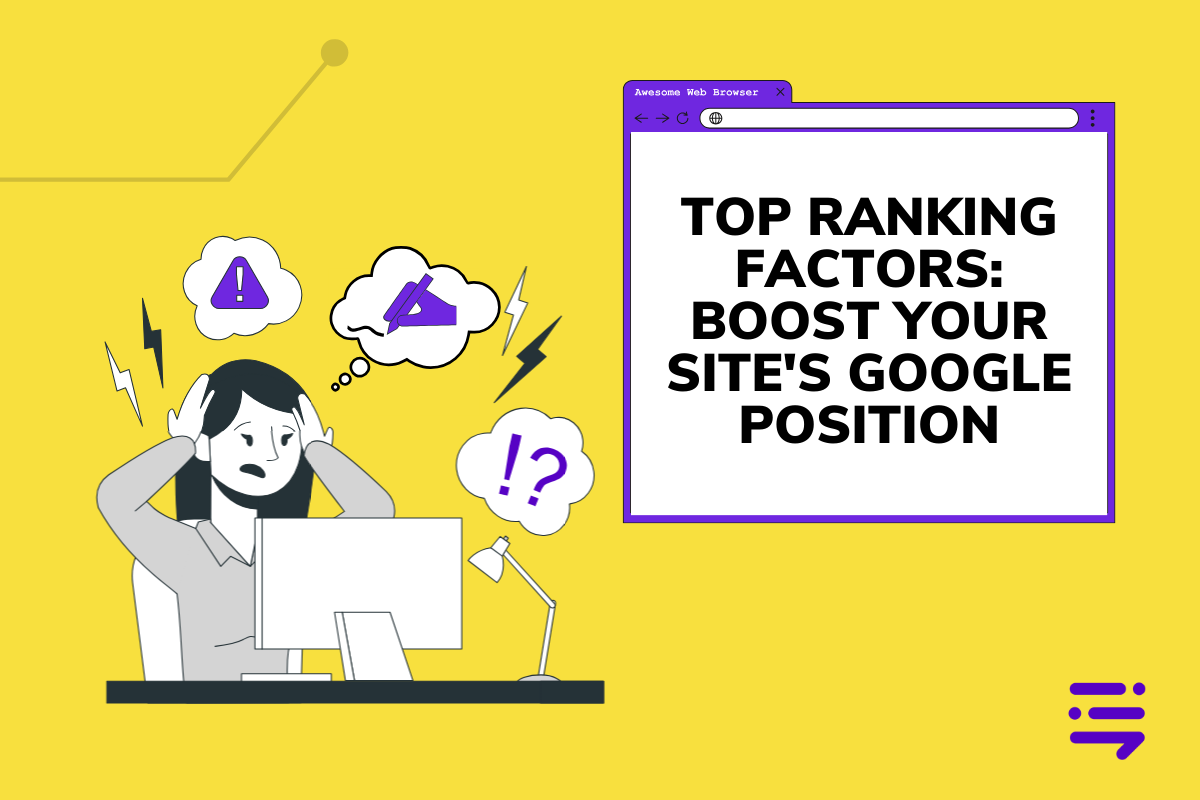
Ranking factors are the VIP pass to the top of Google’s search results. These 200+ items are Google’s criteria for judging the worthiness of your website and where to place them in the SERPs.
Although these ranking factors are top secret, seasoned marketers have cracked the code through observation, experimentation, and analysis.
Here’s a list of some of the well-known ranking factors that could mean the difference between obscurity and visibility for your online presence.
Table Of Contents:
- Top 10 Ranking Factors
- On-Page Ranking Factors
- Website Ranking Factors
- Off-Page Ranking Factors
- Engagement Ranking Factors
- Conclusion
Top 10 Ranking Factors
While there are 200+ Google ranking factors, these are the top 10 you should focus on.
- Content Quality: The quality of your published content is still the most important Google ranking factor. Google prioritizes helpful, in-depth content that addresses user intent.
- Backlinks: Inbound links from other websites signal to Google the credibility and trustworthiness of your site. Quality backlinks from authoritative domains can significantly impact your rankings.
- User Experience (UX): Google loves easy and enjoyable websites. Factors such as intuitive navigation and strategic internal linking play pivotal roles in determining your site’s ranking.
- Keyword Optimization: Strategic placement of keywords in meta tags and throughout the body of your content helps Google understand what your website is all about.
- Page Speed: Google wants its users to have a pain-free browsing experience, which is why page speed is one of the most important ranking factors. If your pages take too long to load, your bounce rate will go up and your ranking will go down.
- Mobile Friendliness: Websites that are optimized for mobile offer better user experiences, which aligns with Google’s UX goal. Mobile-friendly pages also improve user engagement, leading to higher retention rates.
- Domain Authority: Websites with higher domain authority, determined by factors like age, size, and trustworthiness, tend to rank better on Google.
- Technical SEO: Optimizing technical aspects such as crawlability, site structure, and schema markup can positively influence your site’s visibility in search results.
- Social Signals: While not a direct ranking factor, interactions from social media to your website such as likes and shares can impact your SEO efforts.
- Security: HTTPS encryption protects user privacy and prevents unauthorized access to sensitive information. Google has explicitly stated that it gives preference to secure websites in its search results, prioritizing HTTPS-enabled sites over unsecured ones.
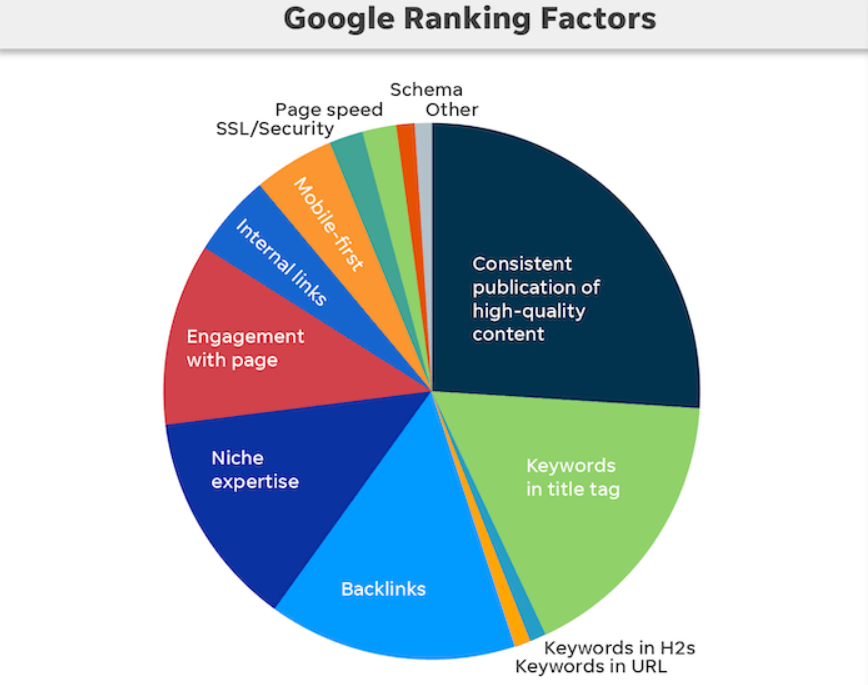
On-Page Ranking Factors
- Keyword in Title Tag: Adding your main keyword to your title tag remains a significant on-page SEO indicator.
- Keyword in the Beginning of Title Tag: Starting your title tag with a keyword typically yields better SEO performance compared to placing the keyword at the end.
- Keyword in Meta Description: Although meta descriptions do not directly influence SERP rankings, they can influence click-through rates which is a pivotal ranking factor.
- Keyword in Headers: Mentioning keywords in H2 and H3 headers may offer a supplementary relevancy signal, helping Google understand the page’s structure.
- Keyword in First Paragraph: Research suggests that including a keyword in the first 100 words of your content (better yet, the first sentence) may boost Page One rankings.
- Table of Contents: Adding a table of contents with links to each section of your article can help Google quickly scan through that page.
- Word Count: Long-form content that fleshes out every angle of a broad topic (like the ones generated by BrandWell) tends to fare better in Google SERPs compared to shorter, superficial articles.
- E-E-A-T (Experience, Expertise, Authoritativeness, Trustworthiness): E-E-A-T represents a set of criteria that Google uses to evaluate the quality and credibility of content, websites, and authors. While it’s not a direct ranking factor in Google’s algorithm, it influences how Google assesses the relevance and reliability of web pages particularly for topics that require expertise such as medical, legal, financial, or news-related content.
- LSI Keywords in Content: LSI keywords help search engines determine the proper context of words that have multiple meanings. For example, Apple the company vs. apple the fruit, or china the dinnerware vs. China the country. Adding LSI keywords to meta tags and the rest of the content may serve as a relevancy signal.
- Duplicate Content: Is your content original or scraped from Google? Copied content, even if slightly modified won’t rank well or may not get indexed at all.
- Bulleted and Numbered Lists: Breaking up heavy text with bullet points and numbered lists is great for readability which aligns with Google’s preferences.
- Image Optimization: File names, alt text, and image descriptions with keywords help search engines understand what the image is all about. Uploading them in proper size and format also ensures they get indexed by Google.
- Content Freshness: Google prefers recently published or updated content, particularly for time-sensitive topics. However, there are cases when an older page that’s frequently updated ranks better than a recently published one.
- Frequency and Scope of Updates: The frequency and extent of content updates influence freshness signals. Rewriting entire sections carries more weight than simply rephrasing words or fixing a typo. How often you update your content — monthly, every 2 years, or never — also impacts freshness.
- Outbound Link Quality: A 2020 study confirmed that linking out to authoritative sites may convey trust signals to Google, potentially influencing rankings.
- Internal Link Quantity and Quality: The number and authority of internal links pointing to a page reflect its importance within the site’s hierarchy.
- Broken Links: Too many broken links may signal neglect, which could hurt a website’s ranking.
- Affiliate Links: While affiliate links are not totally bad, having too many of them might tell Google that your page is a thin affiliate site that brings nothing to the table.
- URL Structure: Shorter URLs and well-structured categories may enhance search visibility, providing thematic signals to Google.
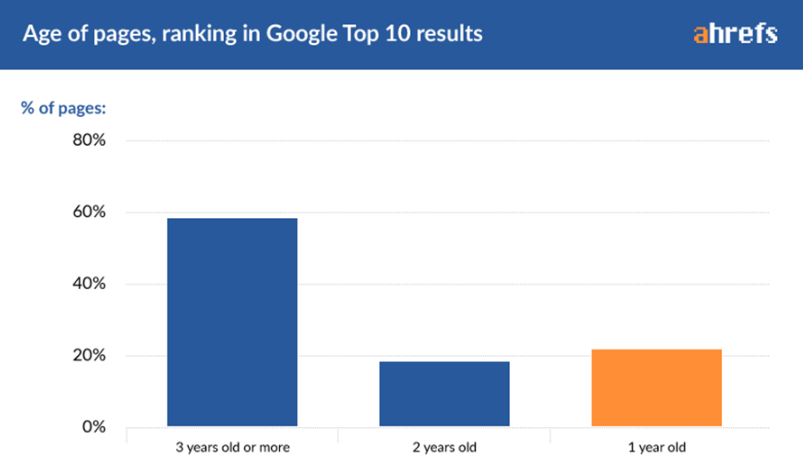
Website Ranking Factors
- TrustRank: TrustRank is a concept that evaluates the trustworthiness of a website based on its credibility, authority, and reputation. It considers factors such as domain age, quality of backlinks, content accuracy, and user engagement. Websites with high TrustRank are deemed more reliable by search engines and are likely to rank higher in search results.
- Contact Page: Including a Contact Us page on your website provides transparency and accessibility for users. It demonstrates that you’re open to communication, which can enhance trust and credibility. From Google’s perspective, websites with clear contact information are seen as more legitimate and trustworthy, potentially leading to better rankings.
- Website Architecture: Website architecture refers to the organization and structure of a website’s pages, including navigation, internal linking, and categorization. A well-structured website with intuitive navigation makes it easier for users to find information and for search engine crawlers to index content.
- Breadcrumb Navigation: Breadcrumb navigation provides users with a hierarchical trail of links that shows their location within a website’s structure. It improves navigation and usability, allowing users to easily backtrack or navigate to related pages. While breadcrumb navigation may not directly influence rankings, it contributes to a better user experience, which can indirectly impact SEO performance.
- Sitemaps: A sitemap is a file that lists all the pages on a website, helping search engines understand its structure and content. Submitting a sitemap to search engines like Google allows them to crawl and index pages more efficiently.
- Website Reputation: Website reputation refers to the overall perception and trustworthiness of a website within its niche or industry. Factors that contribute to a website’s reputation include user reviews, testimonials, mentions on authoritative websites, and social media presence. Websites with positive reputations are more likely to rank higher in search results.
- Server Location: The geographic location of a website’s server can influence its performance and loading speed for users in different regions. While server location itself may not be a direct ranking factor, Google may prioritize websites with servers located closer to their target audience, leading to better rankings for local searches.
- Duplicate Meta: Duplicate titles and meta descriptions can confuse search engines and dilute the relevance of individual pages. It’s important to ensure that each page on your website has unique meta tags that accurately describe its content.
- YouTube: YouTube is owned by Google and is the second-largest search engine globally. Embedding YouTube videos on a website can enhance user engagement and dwell time, factors that Google considers in its ranking algorithm. YouTube videos can also increase the visibility of a website’s content in both YouTube and Google search results, potentially boosting rankings.
- Google Analytics and Google Search Console: Google Analytics and Google Search Console are powerful tools that provide insights into website traffic, performance, and indexing status. While using these tools directly may not impact rankings, they offer valuable data that can inform SEO strategies and optimizations. Monitoring website metrics and addressing issues identified in Google Search Console can improve overall website quality and potentially lead to better rankings over time.
Off-Page Ranking Factors
- Number of Backlinks: The number of backlinks pointing to a website is a significant ranking factor. Generally, websites with a higher number of backlinks tend to rank better, as it suggests authority, popularity, and relevance in their respective niches.
- Types of Backlinks: Different types of backlinks can carry varying degrees of importance. For example, backlinks earned through high-quality content are typically more valuable than links obtained through manipulative tactics like link schemes or reciprocal linking.
- Backlink Domain Age: The age of the domain from which a backlink originates can influence its credibility and authority. Generally, backlinks from older domains are considered more valuable as they often indicate established and trusted websites.
- Authority of Linking Page: Backlinks from pages with high authority such as .edu and .gov domains carry more weight in Google’s algorithm. Such links are considered more trustworthy and impactful for improving search rankings.
- Link Location in Content: The placement of a backlink within the content of a webpage can influence its perceived importance. Backlinks placed within the main body content are generally more valuable than those in headers, footers, or sidebars.
- Backlink Anchor Text: The anchor text used in a backlink provides context about the linked page’s content to search engines. Relevant and descriptive anchor text helps search engines understand the topic of the linked page, positively impacting rankings.
- Links from Ads: Backlinks generated from paid advertisements typically carry less weight compared to organic backlinks. While they may still drive traffic, they are not as valuable for SEO purposes.
- Nofollow Links: Nofollow links are HTML attributes that instruct search engines not to pass PageRank or authority to the linked page. While they may not directly impact rankings, they can still contribute to traffic and brand visibility.
- Links from Competitors: Backlinks from competitor websites can provide valuable insights and exposure, but their impact on rankings depends on the context and relevance of the linking page.
- Links from Bad Neighborhoods: Backlinks from spammy or low-quality websites, also known as bad neighborhoods, can harm a website’s reputation and rankings. Google may penalize sites associated with such links through algorithmic or manual actions.
- User-Generated Content Links: Backlinks generated from user-generated content, such as forum posts, comments, or guest blog contributions, can vary in quality. While some may provide valuable contributions and legitimate references, others may be spammy or manipulative, potentially affecting rankings.
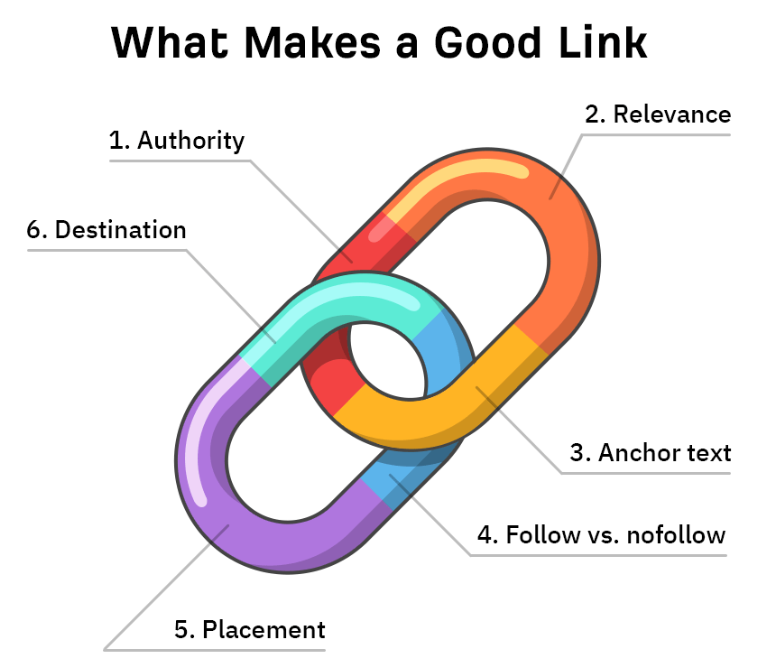
Engagement Ranking Factors
- RankBrain: RankBrain is a machine learning AI component of Google’s search algorithm. It is designed to analyze how people interact with search results and determine rankings accordingly.
- Organic CTR: Organic click-through rate (CTR) refers to the percentage of users who click on a search result after seeing it in the SERPs. A high organic CTR indicates that a search result is relevant and compelling to users, potentially leading to higher rankings for the associated keywords.
- Direct Traffic: Direct traffic refers to visits to a website that occur when users directly type the website’s URL into their browser or access it through bookmarks or saved links. While direct traffic itself is not a direct ranking factor, it can indirectly influence rankings by indicating brand popularity, user trust, and relevance.
- Bounce Rate: Bounce rate measures the percentage of visitors who navigate away from a website after viewing only one page. A high bounce rate may signal to Google that the content on a page is useless or irrelevant, or that user experience is poor, potentially leading to lower rankings.
- Pogosticking: Similar to bounce rate, pogosticking occurs when a user clicks on a search result, visits a page, then returns to the search results page and clicks on a different result. High instances of pogo-sticking may indicate to Google that the initial search result did not satisfy the user’s query, potentially leading to a demotion.
- Chrome Bookmarks: While Google does not explicitly use Chrome bookmarks as a ranking factor, bookmarks can indirectly influence rankings by driving direct traffic to a website. Websites with a high number of Chrome bookmarks may experience increased direct traffic, which can signal popularity and relevance to Google.
- Number of Comments: User-generated comments on a webpage can indicate high user engagement. While comments themselves are not a direct ranking factor, a high number of comments may indicate content quality and relevance.
- Dwell Time: Dwell time refers to the amount of time a user spends on a webpage before returning to the search results. A longer dwell time may signal to Google that the content is valuable and engaging, potentially leading to higher rankings.
- User Browsing History: Google may personalize search results based on a user’s browsing history, including past search queries, visited websites, and interactions with search results.
- User Search History: Similar to browsing history, Google may personalize search results based on a user’s past search queries and interactions. Search history can influence the types of search results users see, potentially affecting rankings for specific queries.
- Safe Search: Safe Search is a feature offered by Google that filters explicit or inappropriate content from search results. Websites containing adult content or violating Google’s content guidelines may be filtered from search results, potentially leading to deindexing.
- DMCA Complaints: The Digital Millennium Copyright Act (DMCA) provides a mechanism for copyright holders to request the removal of infringing content from websites. Websites with a history of copyright infringement may face penalties from Google, including removal from search results.
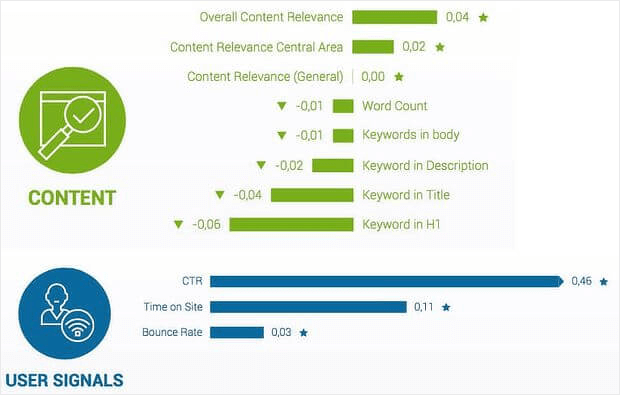

With Google cracking down on spam content following its announcement of the March 2024 Core Update, marketers, publishers, and business owners must be aware of these ranking signals and adjust their SEO strategy to improve their website’s SERP ranking and avoid getting penalized.
Conclusion
While this may seem like an exhaustive list (it’s only 60+ of 200+ known ranking factors), what truly matters is to align your website content with Google’s ultimate goal: to provide users with relevant, helpful content together with an extremely satisfying browsing experience.
Need help creating consistently good content? BrandWell can generate high-quality, in-depth, and SEO-friendly blog drafts designed to support your SEO efforts and engage your audience.
Unlock the potential to create impactful content that captivates audiences and climbs the SERPs. Your journey to digital success starts now.

UNLOCK YOUR POTENTIAL
Long Headline that highlights Value Proposition of Lead Magnet
Grab a front row seat to our video masterclasses, interviews, case studies, tutorials, and guides.

